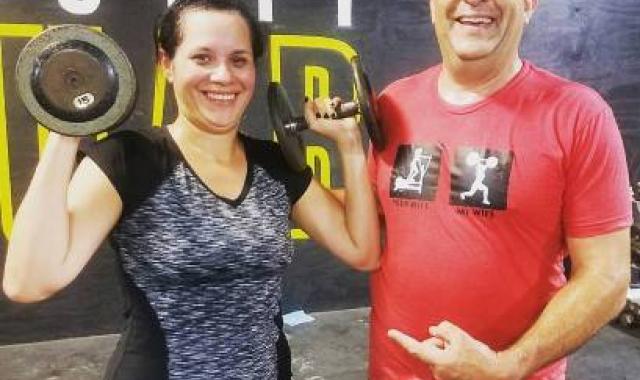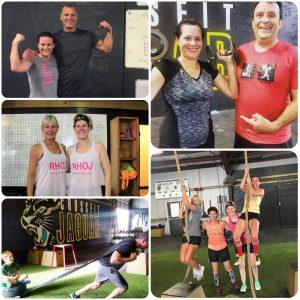
Being of the age and a CrossFit box owner I get asked frequently about CrossFitting in your 50’s and even by some in their 40’s – “I’m too old for that”, “that’s for the younger generation”, “my joints couldn’t take it”.
First, let’s define CrossFit. Keeping with the textbook def: “CrossFit is constantly varied functional movements, performed at high intensity and infinitely scalable.” That pretty much sums it up. In addition, the question - ‘what are you training for?’ needs to be addressed. Not everyone’s goals are the same.
In general most of our clients/prospective clients want to “tone, lose weight and feel better and healthier”. If those are your goals then yes, CrossFit can be for you – whether in a private, semi private or group environment.
There are definitely some dos and don’ts for the more mature person looking to CF and generally they will fall into one of four categories:
- The Athletic All My Life: an athlete in high school, maybe even college it came easy to them, they have great body awareness and flexibility and they have never stopped for long. They maintained their weight, kept active and are well on their way to aging gracefully (approx. 10% of the pop and that’s being generous).
- Mr./Ms. Corporate America: active in their youth or for a time, family and career have taken them from track to couch. They have careers, families, little time and all of the other concerns that make their way into excuses. They have gained a little weight, lost muscle and strength and are beginning to notice some age related decline. (60% plus)
- The Late Bloomer: they weren’t all that active or athletic in their youth but began making changes in their 30’s to prevent decline. They are the ones that start competing and living the lifestyle as a preventive measure trying to maintain or reclaim their youth. (20%)
- The Help I’ve Fallen & I can’t Get Up: were either never active or active for only a short period of time. They have not eaten right or exercised for decades; genetics, lifestyle and fate have them on medications and/or they are very orthopedically challenged. They are destined for further decline and the nursing home unless serious changes are made. And soon. (10%, perhaps more)
#1’s can typically go right into the mainstream CrossFit classes after an assessment and on ramp series to familiarize themselves with the technical aspects of the lifts. #’s 2 and 3's are best thoroughly assessed then the best starting place can be determined whether that be private, CrossFit Lite or CF. #4 needs the TLC of some one on one private training before even considering the group environment. Our goal is to improve these people without further aggravating existing injuries and orthopedic concerns and their training will need to be tailored to their individual needs and limitations in the beginning.
Some important things to consider before sprinting to your local box; most all at this age combat some daily physical condition, from nagging aches and pains to chronic health issues. Some control their ailments with medications others see aggressive training and competition as their lifeline. Start slowly and train wisely:
- Consult First: Be leery of any gym that is ready to throw you right in without assessing your current health, exercise history and goals. Before setting foot on the workout floor these areas should be addressed and assessed with one of their coaches. Not everyone and especially those over 50 are ready for prime time playing. Not that you can’t get there but it must be done correctly and at the appropriate pace. Do your research and if that’s not how they operate look elsewhere.
- Limitation and Mindset: the heart and mind may be forever 25 but your body and joints most likely are not. The reality is we’re older; we’ve lived through challenges and adversities such as birth, death, responsibilities, divorce, relocation, financial despair, etc that would crush our younger counterparts. We’re hardened and wizened but most of us haven’t escaped without injuries or joint wear and tear. Along with being aware we also need to use the mental toughness and discipline that only many years of life can provide to make up for the physical decrements that this same longevity brings about.
- Recovery & Intensity: this is HUGE. Volume and frequency must be cut in order to train regularly. It takes longer to recover than it did in our 20’s and 30’s. In regards to intensity it’s pretty much the same as in younger athletes. You can train as hard just not as often. Keeping the “intensity”, which is relative to the individuals current fitness level, will more closely mimic the purpose of ideal training.
- Progression. Start appropriately - this is primarily on the shoulders of the coach but you must also take responsibility and communicate with them. If you haven’t worked out in 10 years don’t jump in with guns a blazing. You will either throw up, be so sore you can’t move for a week or get injured. Begin at the right level and pace; progress in a manageable and achievable fashion. We’re in it for the long game.
- Check the ego: especially with the weight. Form and technique must be first, weight and speed come second and third.
- Seek a specialist (if necessary): many aches and pains will go away on their own when we start eating right and exercising; some won’t and may require the aid of a specialist such as but not limited to a physical therapist, chiropractor, massage therapist or orthopedic physician.
- Be patient: you didn’t get into this state overnight and it will won’t resolve itself that way either, it will take time to see results and positive changes but they will come to those that work hard, smart and consistently
- Effort & Sacrifice is required. You will sweat, breathe hard and be sore. Embrace it – it means good stuff is happening. Yes, you will need to make lifestyle changes in both consistent workouts and your nutrition but the quality of life you gain will be well worth the efforts.
- The Why: determine why you are doing this. Do you want to reverse the aging process, improve health, have a better of quality of life, more energy and regain strength/muscle tone and functionality? If the answer is yes you have found the holy grail. Approach with an “I can” attitude.
- Scaling: So, you’ve had a few knee surgeries and a hip replacement – high volume box jumps and pounding the pavement aren’t the best thing for you. Substitutions: step ups and rowing/cycling. You’ve got a cranky shoulder from years of throwing and limited mobility – high volume kipping and ballistic overhead movements may not be the best thing for you. Substitutions: strict/ stabilizing movements and lowered volume. When conditioning, the almighty factor is not the mode; there are always ways to achieve the same intent without adding insult to an existing injury or condition. Your coach will modify as necessary.
- Prepare to be humbled: And this goes for any age group - someone will be faster, lifting heavier and they may even be your own age or older. Focus on your best self; with time, consistent efforts and the right mentality you will improve. You will revive yourself.
Time marches on relentlessly; it's third quarter folks and while it's not too late it's time to get started. Do some research on your local boxes, reflect on your goals and have a list of questions ready. The transformation that CrossFit has to offer is yours for the taking - make the second half your best half! And remember age is just a number.

